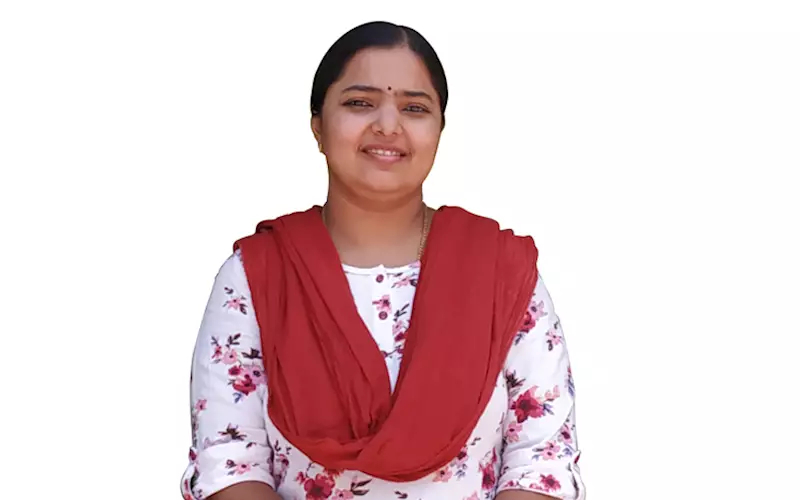Women Power: Shyamala Viswanathan
Shyamala Viswanathan works for Tech Mahindra as a manufacturing controller for Cambridge University Press and carries out the duties of validating product quality issue and maintaining manufacturing quality standards. She is a part of India Procurement team and manages the Global Print Vendor.
06 Aug 2019 | By PrintWeek India
How did you end up in the printing industry?
Shyamala Viswanathan (SV): My scores were average hence I had fewer options. I opted for printing technology. Initially, like many, I wondered what the course would entail since I’d never heard of it. One of the reasons to select this course is my uncle’s advice that there were opportunities owing to the high demand (number of jobs) and low supply (of graduates). He also said, “Print will exist until the world ends.” I have come to realise how true this statement is. The second reason is that my college guaranteed placements.
What is the one thing about print that attracted you – and still attracts you?
SV: There is lot of scope in the field of printing. From e-publishing to various types of printing; very few courses offer such flexibility
List your memories of education in Coimbatore. Did it enable you to examine the ideas that drive our industry? For example, deadlines. In that sense, which was the toughest deadline you had to execute?
SV: A lot of memories are associated with college. We got good exposure in theory, practicals and allied industries. Our professors insisted that we attend in-plant training. They said, “Until you are a student you can ask any question to senior executives; once you become an employee, they test your knowledge.” My college was a great platform to explore and learn.
How many consumers truly understand print? How can we change their attitude?
SV: Understanding consumer needs is a challenge for any industry. However, in the print industry specifically, the customer expects the service to be cost-effective, within a short time-frame for the best quality, and other add ons. In some instances, it is difficult to formulate a focused strategy. I believe, we can sustain and create opportunities only through continual improvement and disruptive innovation.
Stringent turnaround times and fairly modest margins haven’t stopped printers in making a name for themselves. What is your company’s USP?
SV: Cambridge University Press (CUP) is a non-profit organisation and has got great brand reputation. The books are sold because of its quality content and we put a lot of emphasis on the organisation’s culture ‘Customer First’.
Describe your role in the organisation. Also, how does an organisation such as yours operate differently in today’s market, than it did in the past?
SV: In the past, CUP had an in-house printing press, but now we outsource the jobs. Based on the location and demand, we provide jobs to the preferred print vendors. My role is placing orders with the print vendor by following a certain criteria of selection and taking responsiblity for quality, delivery, and effective cost on production.
Shyamala wishlist: How about a tech giant like Google or Microsoft took over a key print and packaging company and you know what happens next. Disruption.
How do you share valuable know-how with your customers? Especially when one looks at the current state of technology and the capabil-ities which are required for publishers / brands / agencies to survive and thrive?
SV: My role does not involve direct interaction with clients.
The industry is very creative, and this is an area that women tend to be strong at. One creative project you handled?
SV: It was the total revamp of our quality issue log.
Is print now a better industry for women to work in?
SV: Of course, with systems like QMS, EMS, FSSC, FSC etc., women have great opportunity in the quality department of the press. Also, women are good at communication skills which are vital today. These natural skills and acquired knowledge on printing opens up opportunities for roles such as customer service representative, production co-coordinator, and project manager among others.
Have you ever felt that your gender placed you at a disadvantage?
SV: I have felt it sometimes but not because of the industry I am in. Generally it’s difficult for a woman to continue her career after marriage, or after child birth unless she has support from her family and organisation. Nowadays maternity leave and work from home has definitely made it easier but in some manufacturing industries they still hesitate to hire a woman who is unmarried or newly married. In some cases, even promotion and other facilities are restricted. I believe, our society should work on empowerment of women by supporting them during these phases. In my case, thanks to my family and organisation’s support, I crossed this stage without a break in career.
The Indian print industry is made up of 80% men and 20% women, of which women have their strongest representation in non-production roles. How can we ensure there are a significant number of women in policy making and power positions?
SV: I guess a publishing house has more women employees. In manufacturing industries, yes, women are a minority. However, women are dominating in departments such as binding and screen printing. It is only through comprehensive knowledge and identifying and improving the necessary skills that women will lead to breakthrough development in their careers.
Our industry is modern and high-tech. Today advances in technology have eliminated some of the heavy lifting and you do see more women in production now. But how can we make print business an attractive proposition than it was in the 20th century?
SV: With cloud computing and advanced colour matching software, I think the print industry is still evolving.














 See All
See All